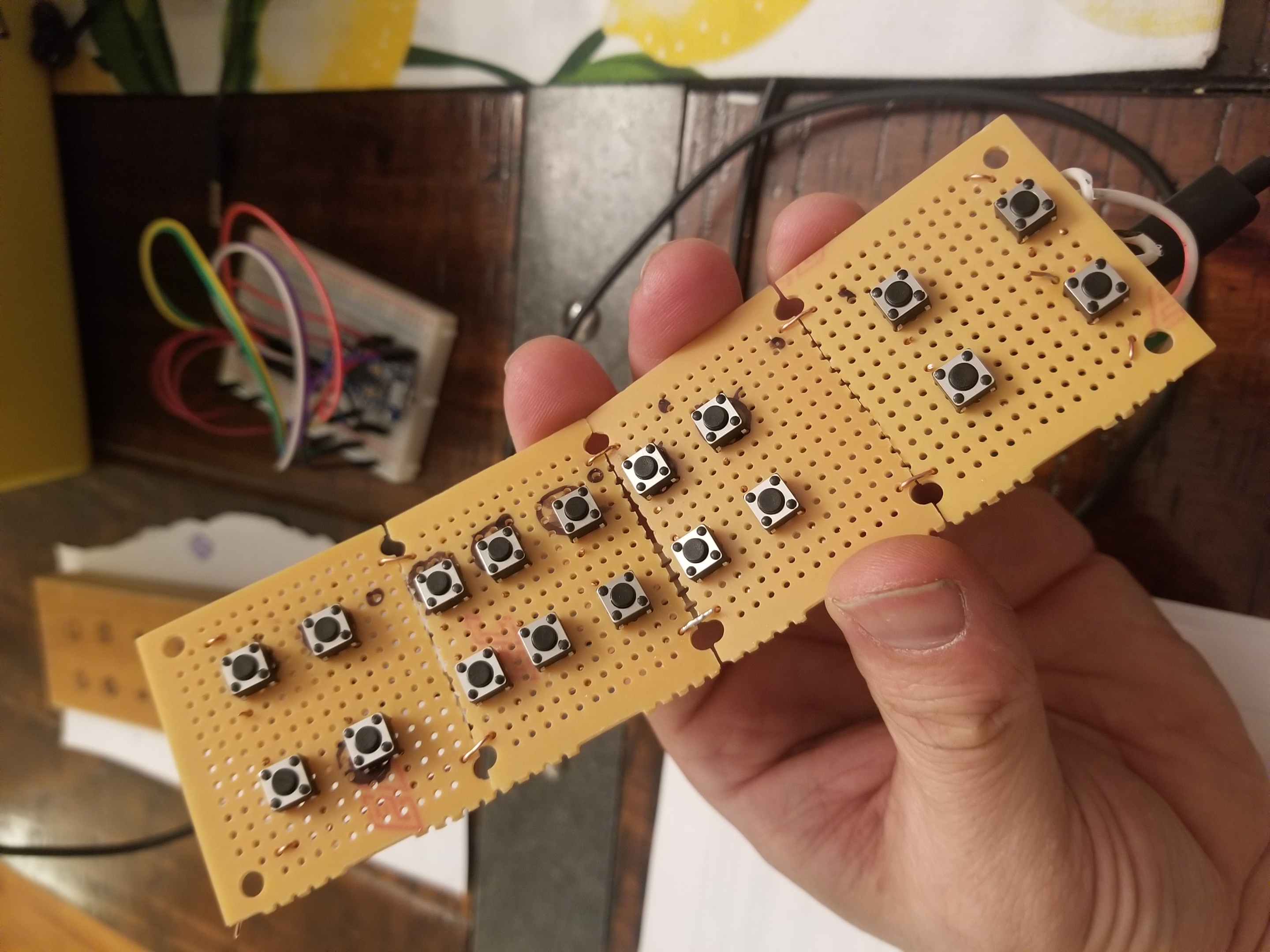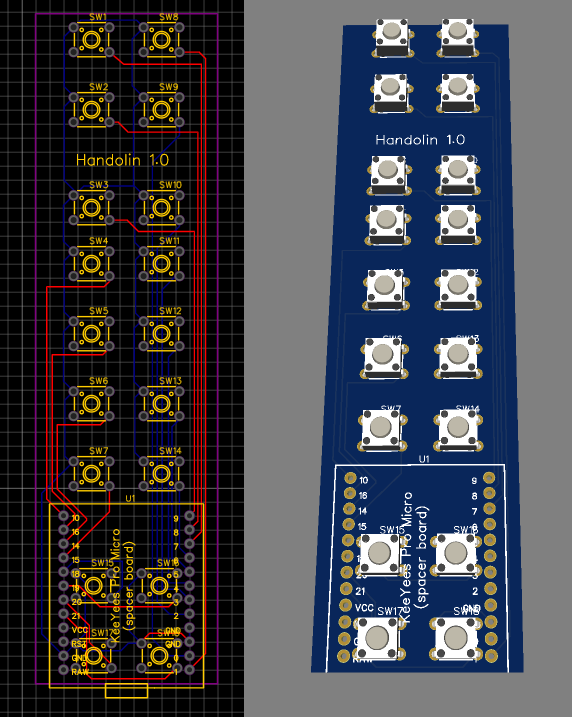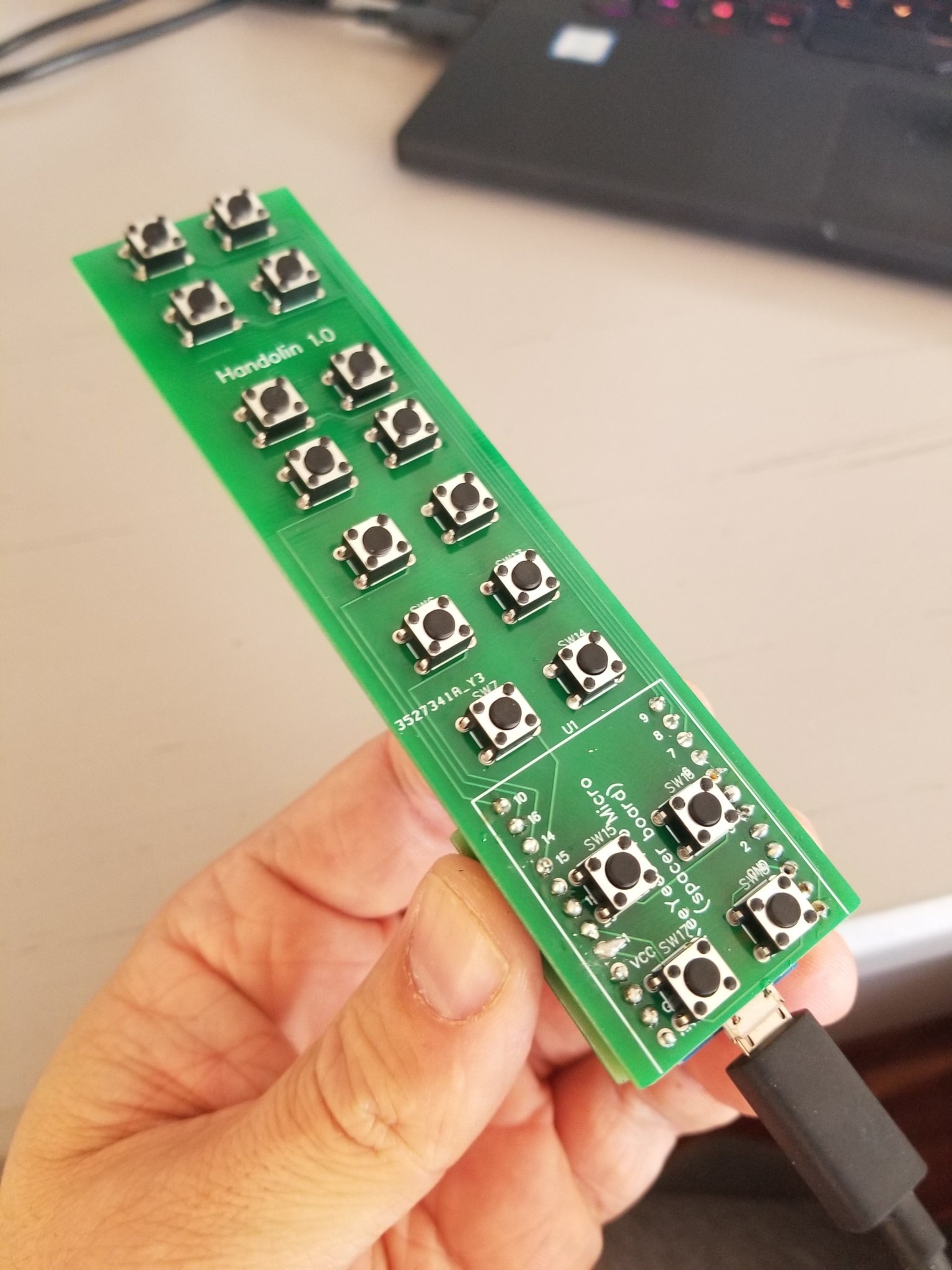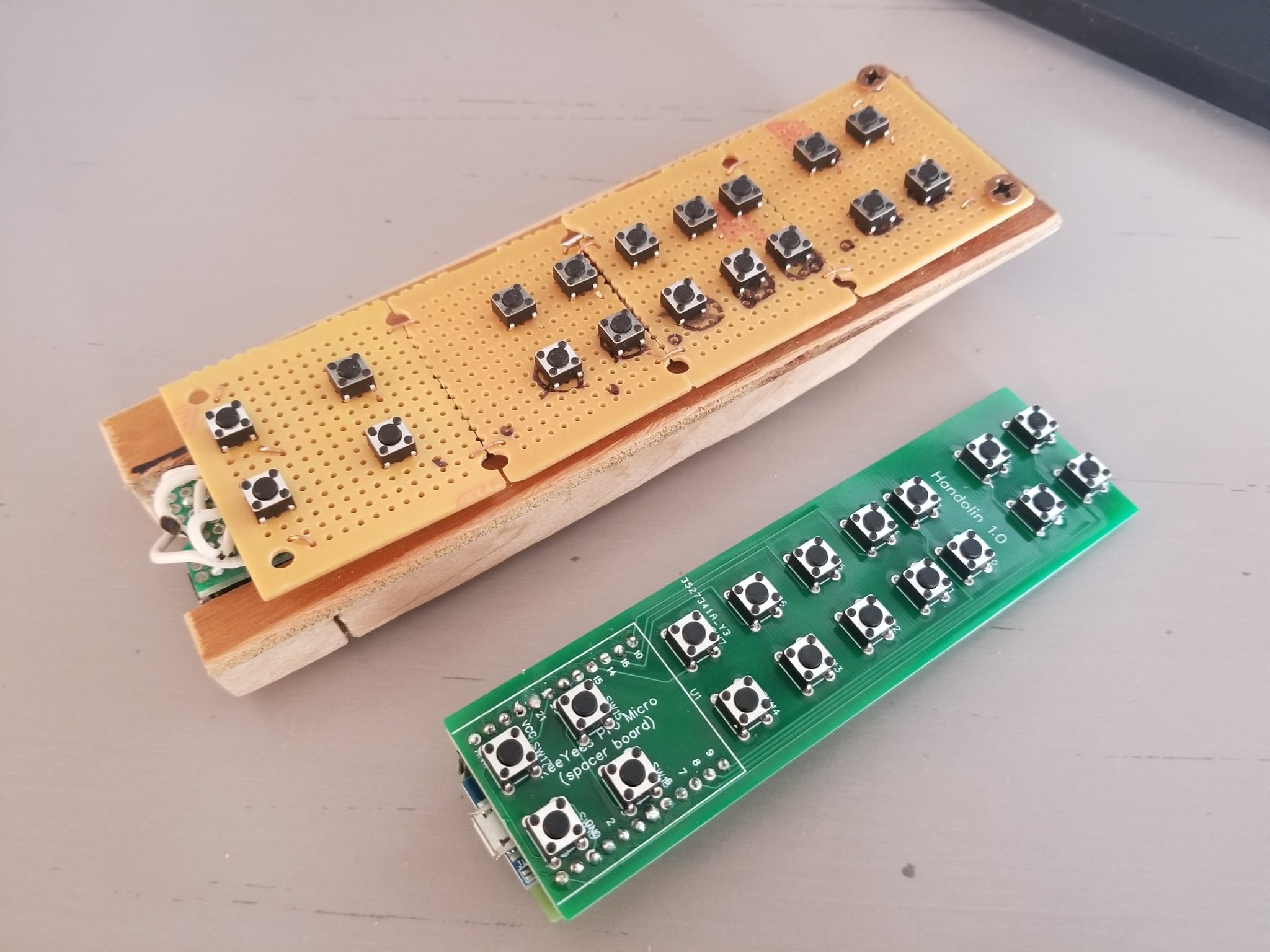|
Wall wart -> diode+fuse -> voltage regulator -> MCU etc. Don't cut the wires on the AC side unless you know what you're doing. My wall wart of choice for low-power projects is a USB-C phone charger. Usually measures 4.5ish V, with a nominal 5.
|
|
|
|

|
| # ? May 23, 2024 23:38 |
|
petit choux posted:Hey! Maybe that helps explain it. I always just assumed low QC and a lot of gear having wider tolerances than stated. I think I like your explanation a lot better. It's a general rule for all sorts of power supplies. Testing with no load (or a very tiny load like, say, your multimeter's megaohm-scale voltage test mode) can give a false sense of what the power supply will do under load. Many types of power supply, especially cheaper ones, need some load to stabilize. And many battery chemistries will float and read a "full" voltage even when they're nearly dead as long as they aren't sourcing any significant current. Car batteries are notorious for this; you can have a battery that reads the full 12.6v when the car is off, so it seems fine, but if you keep the multimeter on while cranking the starter you'll see it instantly drops to zero as the relay closes. Basically if you want to test wall warts just get yourself like a 2W ~50-ohm resistor (=100mA on 5v, 240mA on 12v, etc) and connect that across the output before testing. Sagebrush fucked around with this message at 16:20 on May 31, 2021 |
|
|
|
What is generally considered the standard magnification and diopter for soldering work? I need a magnifying lamp bad.
|
|
|
|
Marsupial Ape posted:What is generally considered the standard magnification and diopter for soldering work? I need a magnifying lamp bad. I don't think there's a standard. I use a binocular visor type magnifier, almost always with the 2.5x lenses for wider view and more depth of field (though it's still narrow in DoF) if I want magnification while I'm soldering. For inspection, I use a little 10x loupe. Edit: Or rather, I think it's highly personal preference based. Really, I almost always solder without magnification and inspect afterwards with the loupe. But I also don't get any super small components in general, usually 805 resistors and 603/805 capacitors (I'd get 805 all the way around but some capacitors values were a good bit more expensive in 805 when I was buying them). Forseti fucked around with this message at 13:54 on Jun 1, 2021 |
|
|
|
Forseti posted:I don't think there's a standard. I use a binocular visor type magnifier, almost always with the 2.5x lenses for wider view and more depth of field (though it's still narrow in DoF) if I want magnification while I'm soldering. For inspection, I use a little 10x loupe. Anything higher than 10x magnification is too much in my experience, you wind up with a tiny depth of field. I usually use either nothing or a cheap 2.5x visor during hand assembly, then a 10x loupe to check the joints and make sure none of the smaller packages have bridged pins afterwards. I like this loupe, it's not too expensive but very high quality: https://www.amazon.com/BelOMO-Triplet-Folding-Magnifier-Anti-Reflection/dp/B00EXPWU8S
|
|
|
|
I have that loupe and it's pretty nice, but you need to light the object from the side a bit, because the loupe blocks a lot of light if it's coming from above.
|
|
|
|
Is there a good standard connector for isolated low voltage + / - with grounded shield? The only thing I can think of are XLR or these cheap lovely connectors that are all over Amazon: But it seems like something there'd be a better/more standard solution for. This is for getting a clean, low voltage, low current (like less than an amp) power supply from one box to another, and XLR seems a bit... chonky for that... e: I guess those shiny shielded RJ-45 connectors for CAT6 ethernet would work if I just ignore like 6 of the pins, but I'm not sure if I wanna make a thing you can plug your computer into by accident and dump an amp of random voltages into it... e2: Huh there's a "mini-XLR" I've never seen before, that seems pretty okay Shame Boy fucked around with this message at 23:27 on Jun 1, 2021 |
|
|
Shame Boy posted:Is there a good standard connector for isolated low voltage + / - with grounded shield? The only thing I can think of are XLR or these cheap lovely connectors that are all over Amazon: It would depend primarily on how permanent an installation you are setting up and the length of the cable run you're looking at. The XLR or mini for things you would be moving around a lot and power over ethernet for anything where the risk, as you say, of accidentally connecting to a computer would not be so great, like a permanent installation where it's always plugged in. And both XLR and RJ45 are capable of long runs but I think the RJ45 is capable of longer. XLR can handle being kinked or stepped on better. That is its main advantage. https://en.wikipedia.org/wiki/Power_over_Ethernet
|
|
|
|
|
Shame Boy posted:e: I guess those shiny shielded RJ-45 connectors for CAT6 ethernet would work if I just ignore like 6 of the pins, but I'm not sure if I wanna make a thing you can plug your computer into by accident and dump an amp of random voltages into it... Normal ethernet is inductively coupled at the port and isolated to something like 600V. If you use RJ45 with PoE jacks and inject the DC power on the appropriate pins it shouldn't cause an issue for a PC that gets plugged into that port, other than not having any data of course. Still, it's best to avoid using 'standard' connectors in a non-standard way if possible, or to label the port as non-standard in a really clear way if you need to use them anyway. e:  This is kinda typical of a PoE jack, if you want to inject a DC voltage you would inject it on say VC+ and it would go out on both MX1+ and MX1- with the AC ethernet signal added on top by the transformer. Then a mirrored version of the same port would pick up the DC voltage on the other end out of VC+. PDP-1 fucked around with this message at 03:24 on Jun 2, 2021 |
|
|
Shame Boy posted:Is there a good standard connector for isolated low voltage + / - with grounded shield? The only thing I can think of are XLR or these cheap lovely connectors that are all over Amazon: You'll probably be good with like a DIN connector? The product answer is MIL-DTL-38999 series 3 connectors. But "standard" is rarely ever "economical". They are unarguably best though, Brought to you by Amphenol, Glenair, & TE each sells cross-compatible parts. Tooling will run you a cool $200 for the crimp and positioner and the connectors themselves get real expensive if you start adding in options like backshells and strain reliefs. However, if you get a crimp & positioner they're also the same type of tooling for the beautiful (unshielded) plastic equivalents to 38999's everybody has, as well as things like Deutsch's DTM/DT/DTP series which are another highly recommended system. Just remember to be very specific with your part numbers and consult the multi-hundred page catalogs of different arrangements and inserts.
|
|
|
|
|
I guess my question should have been "what magnification is too much or too little?". I'm currently looking at the magnifying visors. Random rear end question: is there an technical reason I can't find a polypropylene capacitors in 50v 1uf? I want to use them in a lovely little headphone tubepreamp that I want to make less lovely to just middling lovely.
|
|
|
|
Marsupial Ape posted:Random rear end question: is there an technical reason I can't find a polypropylene capacitors in 50v 1uf? I want to use them in a lovely little headphone tubepreamp that I want to make less lovely to just middling lovely. 50V is kind of on the low end for film caps in general. Just use a 100V rated one.
|
|
|
|
M_Gargantua posted:You'll probably be good with like a DIN connector? Oh hell I completely forgot those existed, yeah that's perfect thanks. M_Gargantua posted:The product answer is MIL-DTL-38999 series 3 connectors. But "standard" is rarely ever "economical". They are unarguably best though, Brought to you by Amphenol, Glenair, & TE each sells cross-compatible parts. Tooling will run you a cool $200 for the crimp and positioner and the connectors themselves get real expensive if you start adding in options like backshells and strain reliefs. However, if you get a crimp & positioner they're also the same type of tooling for the beautiful (unshielded) plastic equivalents to 38999's everybody has, as well as things like Deutsch's DTM/DT/DTP series which are another highly recommended system. Just remember to be very specific with your part numbers and consult the multi-hundred page catalogs of different arrangements and inserts. Those look rad as hell but yeah I'm not paying like fifty bucks for the cheapest one, at least not for this project 
|
|
|
|
Question about RF switches / relays - I have a situation where I want to toggle between one of two loads into a VNA. A SPDT - where the two load returns would be common - would seemingly be obvious for this. But I'm curious if there is any reason or consideration for a DPDT arrangement, where both the signal and return path for each load could be switched in independently. This is at 4Mhz so not particularly high frequency, and the loads are actually just two transducer sensors (basically can treat as lumped elements).
|
|
|
|
Stack Machine posted:50V is kind of on the low end for film caps in general. Just use a 100V rated one. Let me more ask a more practical question: are polypropylene capacitors really that much better than monolithic ceramic capacitors for audio applications? Am I just following audiophile hype and buying Monster HDMI cables?
|
|
|
|
I suspect no audible difference
|
|
|
|
It kinda depends on where in the circuit they are. If they're somewhere along a high impedance signal line that then gets amplified, you can get what's called microphonics where they act like little piezo transducers and introduce noise whenever they're vibrated or tapped. Whether or not this is actually a problem depends on a bunch of stuff like the design of the circuit and whether or not it's isolated from vibration. Anywhere else though (like stabilizing voltage rails) and they'll work totally fine.
|
|
|
|
Ceramic capacitors are notoriously nonlinear too. Not a big deal at all for DC blocking caps in AC coupled amplifiers. Might be a little bit more of a problem for (audio signal, not power) filters and the like since nonlinearity causes distortion. The usual way to solve that is to get X7R ceramic caps with higher voltage ratings than you need, so the sub-range you use has more linearity in capacitance.
|
|
|
|
Shame Boy posted:
Does anyone got the Venn Diagram for capacitor types again?
|
|
|
|
I am currently waiting on the components to make several ”BootLegMics” for my brother to use when recording audio (just in noise environments, not actually bootlegging) for his YouTube channel. The design has me kind of fascinated and I’m wondering what other passive circuits I can use with an electret mic using only plug-in power. Unfortunately, I can only find resources for adding Phantom power or the introduction of 9vdc. Anybody have any good links to tutorials or literature plug-in powered circuits for electrets? Edit: and could I get recommendations on a good box kit of assorted passive components? I’m getting really sick of having to buy parts one at a time as I need them. Marsupial Ape fucked around with this message at 10:40 on Jun 4, 2021 |
|
|
|
Marsupial Ape posted:Edit: and could I get recommendations on a good box kit of assorted passive components? I’m getting really sick of having to buy parts one at a time as I need them. That's a little tricky, depends on what you mean by "good". Like you're not gonna find an assortment of nice top of the line capacitors, pretty much all the assortments use cheap stuff. Then again that's not really a problem for just messing around and building stuff. When I was starting out I basically just got one each of separate big assorted packs of resistors, electrolytic caps, polyester caps, and ceramic caps on amazon and that served me well for quite a while. Not sure what specific ones but they're all pretty much the same. However I just went and looked and if you have like $80 to blow, this looks pretty good: https://www.amazon.com/Electronic-Assortment-Capacitors-Transistors-Potentiometer/dp/B08MDQ973T/ It appears to have a lot of everything in there, resistors, caps, buttons, switches, transistors, diodes, even some common chips to play around with. I definitely woulda just gone with something like this if it had been available when I was starting out, I wound up buying basically everything in this box separately anyway. e: Oh one thing to note about that box is it uses blue resistors, which some people hate because it's harder to read the color band code on them. Personally I've never had a problem with it but ymmv. Shame Boy fucked around with this message at 14:17 on Jun 4, 2021 |
|
|
|
One thing I don't like about those kits is that they often cheap out on the resistors and include ones with really thin leads that are easy to break, and they just bend instead of going into a breadboard.
|
|
|
|
Shame Boy posted:That's a little tricky, depends on what you mean by "good". Like you're not gonna find an assortment of nice top of the line capacitors, pretty much all the assortments use cheap stuff. Then again that's not really a problem for just messing around and building stuff. When I was starting out I basically just got one each of separate big assorted packs of resistors, electrolytic caps, polyester caps, and ceramic caps on amazon and that served me well for quite a while. Not sure what specific ones but they're all pretty much the same. Thanks. By ‘good’ assortment I mean the variety. It’s getting frustrating wanting to try a new circuit or method and then having to wait a week to a month or more to get to it for the lack of a common part.
|
|
|
|
I've been working on a music project for a little while now, and a couple of months ago, I managed to complete the code for the Arduino Pro Micro microcontroller to bring this prototype to life. Lots of electronic-music folks use a MIDI keyboard, bang out some keys, record it into their computer, and then mix with all kinds of electronic sounds. I've always wanted to do that, but I don't play the keyboard. I don't think about music through a keyboard. I do it through a violin or mandolin (they're the same strings). There's something about progressing up the strings in 5ths that just makes sense to me. Anyhow, I couldn't find a violin-like MIDI controller anywhere, so I decided to code my own. Well, code, plus engineer the wiring, tie together some circuit boards, solder a bunch of wires together... and voila. This project is more code than components. It's literally just a single Arduino Pro Micro clone and tactile switches. But I figured it belonged here anyway. Step 1: Proof of concept. Getting the code to work properly wasn't too difficult, but definitely more involved than a keyboard-based MIDI controller. On a keyboard, pressing the button makes the sound. On a string, there are "open string" notes and "pressed string" notes, which require the code to pay attention to combination of key presses to simulate "playing the string" vs "pressing on the string in a particular place."  Here's the first functioning prototype:  Next step: designing a PCB:  Assembling:  Side by Side comparison between prototype and v1:  3D modeled and printed case with ergonomics in mind:  And here's the output, through the Reaper DAW using a strings virtual instrument: https://www.youtube.com/watch?v=d9K-EJLtjC4
|
|
|
|
What are people using to store microcontrollers, FPGAs, etc? I have about a dozen different dev boards that don't fit in a normal parts organizer. Hoping for some type of box for them all (ie, not like a built-in).
|
|
|
|
PRADA SLUT posted:What are people using to store microcontrollers, FPGAs, etc? I have about a dozen different dev boards that don't fit in a normal parts organizer. Hoping for some type of box for them all (ie, not like a built-in). I toss all of my dev boards into 8.5x11x1.5 inch document boxes, usually multiple boards per box, and stack said boxes on a shelf. It's not maximally convenient but it's cheap and mostly effective.
|
|
|
|
jovial_cynic posted:Well, code, plus engineer the wiring, tie together some circuit boards, solder a bunch of wires together... and voila. I think you mean ... and violin  That's a very cool result! Also I like how you're doing vibrato on a tactile switch. Does the midi sample apply that effect on sustained notes or do you do it manually by pushing a second switch with your right hand?
|
|
|
|
Cory Parsnipson posted:That's a very cool result! Also I like how you're doing vibrato on a tactile switch. Does the midi sample apply that effect on sustained notes or do you do it manually by pushing a second switch with your right hand? I do it out of habit as an actual violin player. However, the vibrato is 100% coming from the virtual instrument in the DAW. I've considered a v2 of the instrument that will allow me to add a few effects, specifically the vibrato, and perhaps some things like looping or other wild MIDI functions. The only hiccup is that all of the I/O pins on the microprocessor I'm using are used up, so I'd have to either add in a multiplexer, or use a different board entirely. So... that might depend on how many of these guys I sell, and if there seems to be some interest in those added functions. Also... I've referred to this instrument as a "Handolin," or "handheld violin/mandolin" controller. But I programmed a low "C" on the instrument, so it's technically a viola as well.
|
|
|
|
jovial_cynic posted:I do it out of habit as an actual violin player. However, the vibrato is 100% coming from the virtual instrument in the DAW. Nice. As has been recommended by people in this thread to me before, you could add a GPIO expander, a key matrix IC, or do a key matrix manually. I think the pro micro is great cause it's cheap and widely used for keyboards and stuff. I guess there's also the ESP32 family of processors recommended to me by Forseti that should have much more GPIO than you need and is even cheaper to obtain than the pro micro. Are you planning on beefing up the enclosure to be like the top of a mini violin? I think it would be cool, especially if there was enough to hold it in your chin. It would be tougher to print/make something like that though.
|
|
|
|
Cory Parsnipson posted:Nice. As has been recommended by people in this thread to me before, you could add a GPIO expander, a key matrix IC, or do a key matrix manually. I think the pro micro is great cause it's cheap and widely used for keyboards and stuff. I guess there's also the ESP32 family of processors recommended to me by Forseti that should have much more GPIO than you need and is even cheaper to obtain than the pro micro. I've thought about a few different solutions. Every solution would require a redesign of the PCB, which... doesn't sound terribly fun. But we'll see. There are several different ways to do it. I like the key matrix solution, though. Mainly because it feels particularly elegant and magical. Very clever solution. Anyhow, I wanted the instrument to be a handheld device, not a full-size violin. The instrument, as is, is ergonomically very similar to the violin neck, so it works as intended. I've given some thought about enclosing the top, so the PCB isn't exposed, but I'm not super good at 3D modeling yet, so it might take me a bit of work to get it sorted. But we'll see!
|
|
|
|
Marsupial Ape posted:Thanks. By ‘good’ assortment I mean the variety. It’s getting frustrating wanting to try a new circuit or method and then having to wait a week to a month or more to get to it for the lack of a common part. Ah, yeah I'd still say get that box if you got the cash. Other than that, all the resistor/capacitor assortments out there are gonna be roughly similar, just look for ones that have a good number of things in them and range of values. I think Jameco-branded ones use slightly nicer parts but they're also more expensive so eh up to you. Also read up on the theory behind E-numbers a bit if you haven't already. Basically, thanks to the way component values are set up, you can make sure you're always within a certain percent tolerance of any arbitrary value without having to actually stock every possible value. I mention this cuz a lot of assortment kits will explicitly say they're "E12" or "E24" etc. and that's what that's about.
|
|
|
|
Shame Boy posted:Ah, yeah I'd still say get that box if you got the cash. Other than that, all the resistor/capacitor assortments out there are gonna be roughly similar, just look for ones that have a good number of things in them and range of values. I think Jameco-branded ones use slightly nicer parts but they're also more expensive so eh up to you. Thanks. I did some window shopping and it will cost me about $100 to put together my own kit from smaller kits. Speaking of Jameco, one's I get the necessities square away, I have every intention of purchasing a few of their Grab Bags. I am a sucker for crap like that. Marsupial Ape fucked around with this message at 20:31 on Jun 4, 2021 |
|
|
|
Not to bring up the poo poo from a few pages back, but THIS is the step down AC power supply, isn't it? Always when I stop actively looking...
|
|
|
|
The outputs on that are DC. Regulated AC-to-AC power supplies aren't exactly common.
|
|
|
|
Stack Machine posted:The outputs on that are DC. Regulated AC-to-AC power supplies aren't exactly common. poo poo, you're right. I misread the output as VAC...twice. Guess I need to clean my glasses. I'm gonna find one one day, goddamit. Edit: I found it and it doesn't inspire confidence. Edit: Ok, I found a legitimate AC-to-AC variable transformer. I'm not going to buy it, but I am now emotionally satisfied. Now, I'll shut up about it. Marsupial Ape fucked around with this message at 02:46 on Jun 5, 2021 |
|
|
Taking poo poo apart again, working my way towards repairing some stuff but I wanted some parts out of this, a discarded floor display.  It appears to be a limited run display model that's got most of its features disabled. But it had a few things I needed:  This takes a 12v in, puts out a 9v, 3 x 5v and one 12v. The three main voltages you'll need for various music hardware.  And I think this has an audio player on it, among other things, but I'm suspecting a lot of the disabled features aren't in this machine and it was probably a short run of demo models. Maybe you guys can tell me. I also tried to look up that chip on what I'll call the CPU, my quick GIS turned up a bunch of chips that don't resemble it at all:  I wanted connectors, screws, switches, wire, that power board, the cute little speaker, maybe the LCD array. Anyway, this is not what I'm really doing this evening, I'm like a raccoon, I love taking poo poo apart. Of course this came from a dumpster. Department stores are always throwing electronics in the dumpster. And I'm in awe of the camera on my phone, even after all these years. You can read all the writing on all these chips, no problem. petit choux fucked around with this message at 03:09 on Jun 5, 2021 |
|
|
|
|
The APS815 bluetooth module probably does all of the heavy lifting. That certainly is a mostly bare board
|
|
|
|
poo poo, that looks fun. I can't wait until yard/garage sales and flea markets are a thing, again, so I can break poo poo for 'science'.
|
|
|
|
ante posted:The APS815 bluetooth module probably does all of the heavy lifting. That certainly is a mostly bare board Huh, that's weird. Why did they lay out a whole board if they didn't need half of the components?
|
|
|
|

|
| # ? May 23, 2024 23:38 |
ante posted:The APS815 bluetooth module probably does all of the heavy lifting. That certainly is a mostly bare board Ah, I had one number wrong, should have gone from the photo instead of squinting through the magnifying lens. Here's another I've been meaning to shred for a little while, a large massage tool. Much simpler. I don't know much about electronics but I know a zener diode when I see it and what four of them together usually means. But I was expecting to see a transformer in there too. Turns out it's a 120v DC motor, and a pretty big one. I've been kinda looking for things with big electric motors lately. Not sure why. But this is def the makings of a nice tool of some sort.  Cory Parsnipson posted:Huh, that's weird. Why did they lay out a whole board if they didn't need half of the components? They wanted to save on floor demos. It's a big retail chain, they did a short run of a few hundred probably. Also it's designed to only play a few seconds of like 4 pieces of music and then shut down.
|
|
|
|




















